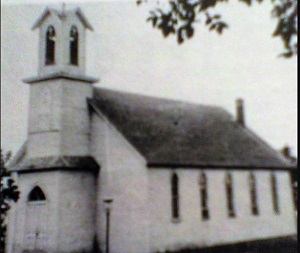
SACRED HEART CATHOLIC CHURCH
Manilla, Iowa
Initially the Catholic Church was a missionary church in Crawford County. Priests from Council Bluffs, Dunlap and Carroll and further east came to the county occasionally to bring the consolations of the religion to the early Catholic settlers, who, at the time, few in number.
Divine services were held in homes of Catholic families and at the old Courthouse in Denison. The missionary Priests, weary and footsore from the perils of bad roads and swollen streams, always found a welcome.
In the early to mid 1870's the first settlers began arriving in the southern part of Crawford County in earnest and among them was a sprinkling of Catholic's. Most of their parents had left Ireland in the 1847-1848 Great famine and went to Canada or Illinois or eastern Iowa before coming to our area.
The town of Manilla was not yet built and these settlers had to travel to Denison or Vail to attend Mass, be Baptized or married. Some of the earliest families were Collins, McMahon, McNertney, Finnegan, McSorely and Murphy.
The first Mass offered in Manilla was in Thews Brothers Hall which stood east of the current bowling alley in Manilla. In 1887, the Milwaukee Rail Road gave one lot to the Catholic parish at Manilla. There were about 35 families at Sacred Heart in 1887 and Father Hugh Byrne was the first pastor. Father Byrne immediately formed a building committee and on that lot the "old" Catholic Church was built.
The first marriage in the old church was John McMahon and Johanna Collins. Father Byrne did not live in Manilla, but served this parish from Manning.
In November, 1887 the first Mass was held in the church and the church was dedicated about Thanksgiving Day of that year by the Very Reverend Philip O'Connor, V.F. of St. Joseph's Church, Carroll, Iowa.
The cost of the church was $1200.00. The original pews were made of pine boards. The altars were fashioned locally and the windows were plain glass. There was no statuary at this time. Later a high altar was donated by the Francis McSorley family and the Altar of the Blessed Sacrament by the Knott family. Frank Knott became the organist in 1895 and served most dependably and faithfully in that capacity for 51 years.
Across the street (to the east) from the church was the Carey home, which was purchased for a convent and three Sisters from the Sorrowful Mother Community in Milwaukee came to Manilla. A small two room school was built just behind the convent. Catholic students would come from the public school at different times of the day for religious education.
Prior to the small school, the church bought a portion of the, then, public school, moved and converted it into a "Sister School". School was held here, with nuns as teachers, until the Depression forced it's closing in 1932. It was then used a a social hall, where, for many years Christmas concerts and plays were held for the Catholic community.
The parish cemetery Mt. Olivet is a five-acre plot on rising ground a half mile east of the town.
The rectory was begun in November 1921 and finished in May of 1922. The current rectory is still in use.

The groundbreaking for the current church took place on 24 March, 1963 and dedicated on 5 March, 1964, with Father Cletus Keleher offering Mass, assisted by Father's Hyland, Frank and Clark, all former pastors at Sacred Heart.
Note - The above is an excerpt from the Sacred Heart Catholic Church History as recorded in the Manilla Community Folks and Facts 1886-1986 Centennial Book. Much of the history was written by Father J.J. Hyland, Pastor at Sacred Heart from 1936 to 1952.
Contributed by Patrick Powers, November 2020
Copyright ©2014, by the Crawford County, Iowa
IAGenWeb Project and Contributors.




